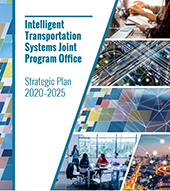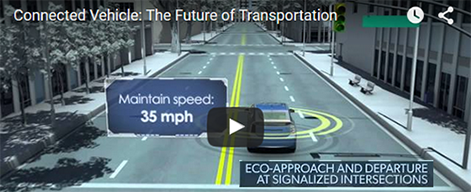
About
The Intelligent Transportations Systems Joint Program Office (ITS JPO)
OUR VISION:
Accelerate the use of ITS to transform the way society moves.
OUR MISSION:
Lead collaborative and innovative research, development, and implementation of ITS to improve the safety and mobility of people and goods.
Planning for the Future of ITS
The ITS Joint Program Officeís 2020-2025 ITS Strategic Plan
About ITS JPO

Current Research
The U.S. Department of Transportationís ITS research focuses on several high-priority areas including Emerging and Enabling Technologies, Data Access and Exchanges, ITS Cybersecurity Research, Automation, ITS4US, and Accelerating ITS Deployment. The ITS Strategic Plan includes in-depth discussion of the ITS Programís strategic goals, these research areas, and four technology transfer programs.
Learn more in the 2020-2025 ITS Strategic Plan.
Research Areas

Intelligent Transportation Systems Deployment
| Connected Vehicle Pilots | ||
|
View NYCDOT pilot |
View THEA pilot |
View WYDOT pilot |
ITS Deployment
- ITS4US
- Vehicle-to-Infrastructure Resources
- Connected Vehicle Pilots
- Connected Vehicle News and Events
- Connected Vehicle Deployer Resources
- Connected Vehicle Deployment Assistance
- Connected Vehicle Applications
- Sample Deployment Concepts
- Connected Vehicle Publications
- National ITS Architecture
- Smart City Challenge

Technology Transfer
  |
  |
Technology Transfer
Research Archive
- Safety
- Vehicle-to-Vehicle (V2V) Communications for Safety
- Truck V2V Research
- Transit V2V Research
- Connected Vehicle Safety Pilot
- Vehicle-to-Infrastructure (V2I) Communications for Safety
- Truck V2I Research/Smart Roadside
- Transit V2I Research
- Connected Vehicle Safety for Rail
- Vehicle-to-Pedestrian (V2P) Communications for Safety
- Ann Arbor Connected Vehicle Test Environment (AACVTE)
- Mobility
- Environment
- Road Weather
- Policy
- Connected Vehicle Technology
- CV Pilots Deployment Project
- Automated Vehicle
- Intermodal
- Exploratory
- ITS Cross-Cutting Support
- Success Stories
- Clarus
- Commercial Vehicle Information Systems and Networks (CVISN) Core and Expanded Deployment Program
- Congestion Initiative
- Cooperative Intersection Collision Avoidance Systems (CICAS)
- Electronic Freight Management
- Emergency Transportation Operations (ETO)
- Integrated Vehicle-Based Safety Systems (IVBSS)
- Intelligent and Efficient Border Crossings
- Mobility Services for All Americans (MSAA)
- Next-Generation 9-1-1
- Rural Safety Initiative
- Vehicle Infrastructure Integration

Applications for the Environment: Real-Time
Information
Synthesis (AERIS) Program
Appendix D
Track 3 – Analyze and Evaluate Candidate Strategies and Applications
The next phase will allow the selected applications/strategies to be further developed, analyzed, and evaluated to confirm that the initial assumptions are still valid and to develop firm expectations of their potential contributions. Some of the activities needed to evaluate the applications/strategies are:
- Detailed and extensive cost/benefit analyses – undertake basic analytics to assess the costs of current technology and data options, including communications and hardware costs, and compare with the quantified benefits of ITS to the environment. Identify how benefits might be quantified. Might the cost per ton of carbon emissions avoided be an appropriate measure of the benefits of ITS technologies? Conduct a gap analysis to better understand what additional information is required to credibly analyze benefits and costs.
1200 New Jersey Avenue, SE • Washington, DC 20590 • 800.853.1351





